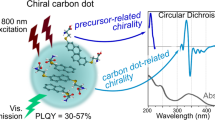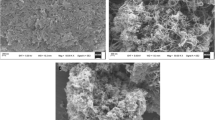Abstract
A room temperature ultrasound-assisted method was applied to synthesize L- and D-cysteine-capped CdSe quantum dots (QDs). The QDs were characterized by XRD, FT-IR, and TEM. They have diameters of 5–7 nm and are shown to be viable probes for highly selective chiral recognition of tryptophan (Trp) enantiomers by fluorometry. The green fluorescence of the capped QDs (with excitation/emission maxima at 380/527 nm and 380/520 nm for L-Cys and D-Cys QDs, respectively) is differently quenched by D- and L-Trp in a high selective manner, with negligible interference by other species. The calibration plots and corresponding Stern-Volmer plots for both Trp enantiomers were investigated by two different approaches: In the first, each individual enantiomer was tested. In the second, each enantiomer was tested in the presence of a 100-folds excess of the other enantiomer. The detection limits for the recognition of L- and D-Trp are 4.2 and 4.7 nM, respectively, for the first approach. In the presence of the other enantiomer, the LODs are 4.4 and 4.8 nM. The linear range extends from 0.1 to 15 μM for both enantiomers.

Schematic representation of tryptophan (Trp) chiral recognition process. The fluorescence (green, ON) of D- and L-Cys (cysteine)-capped CdSe QDs is quenched (black, OFF) through a preferential and selective interaction with L- and D-Trp, respectively.






Similar content being viewed by others
References
Petryayeva E, Algar WR, Medintz IL (2013) Quantum dots in bioanalysis: a review of applications across various platforms for fluorescence spectroscopy and imaging. Appl Spectrosc 67:215–252
Wang Y, Chen L (2011) Quantum dots, lighting up the research and development of nanomedicine. Nanomedicine Nanotechnology, Biol Med 7:385–402. https://doi.org/10.1016/J.NANO.2010.12.006
Zhao M, Chen Y, Han R, Luo D, du L, Zheng Q, Wang L, Hong Y, Liu Y, Sha Y (2018) A facile synthesis of biocompatible, glycol chitosan shelled CdSeS/ZnS QDs for live cell imaging. Colloids Surfaces B Biointerfaces 172:752–759. https://doi.org/10.1016/J.COLSURFB.2018.09.002
Frigerio C, Ribeiro DSM, Rodrigues SSM, Abreu VL, Barbosa JA, Prior JA, Marques KL, Santos JL (2012) Application of quantum dots as analytical tools in automated chemical analysis: a review. Anal Chim Acta 735:9–22. https://doi.org/10.1016/J.ACA.2012.04.042
Liu Q, Jiang M, Ju Z, Qiao X, Xu Z (2018) Development of direct competitive biomimetic immunosorbent assay based on quantum dot label for determination of trichlorfon residues in vegetables. Food Chem 250:134–139. https://doi.org/10.1016/J.FOODCHEM.2017.12.079
Moloney MP, Govan J, Loudon A et al (2015) Preparation of chiral quantum dots. Nat Protoc 10:558
Carrillo-Carrión C, Cárdenas S, Simonet BM, Valcarcel M (2009) Selective quantification of carnitine enantiomers using chiral cysteine-capped CdSe (ZnS) quantum dots. Anal Chem 81:4730–4733
Horikoshi S, Serpone N (2013) Microwaves in nanoparticle synthesis: fundamentals and applications. John Wiley & Sons
Xu H, Zeiger BW, Suslick KS (2013) Sonochemical synthesis of nanomaterials. Chem Soc Rev 42:2555–2567
Xiong H, Shchukin DG, Möhwald H et al (2009) Sonochemical synthesis of highly luminescent zinc oxide nanoparticles doped with magnesium (II). Angew Chemie Int Ed 48:2727–2731
Chen D, Sharma SK, Mudhoo A (2011) Handbook on applications of ultrasound: sonochemistry for sustainability. CRC press
Berthod A (2006) Chiral recognition mechanisms. Anal Chem 78:2093–2099
Lämmerhofer M (2010) Chiral recognition by enantioselective liquid chromatography: mechanisms and modern chiral stationary phases. J Chromatogr A 1217:814–856. https://doi.org/10.1016/J.CHROMA.2009.10.022
Wypchlo K, Duddeck H (1994) Chiral recognition of olefins by 1H NMR spectroscopy in the presence of a chiral dirhodium complex. Tetrahedron Asymmetry 5:27–30
Kuhn R, Erni F, Bereuter T, Haeusler J (1992) Chiral recognition and enantiomeric resolution based on host-guest complexation with crown ethers in capillary zone electrophoresis. Anal Chem 64:2815–2820. https://doi.org/10.1021/ac00046a026
Thompson AL, Watkin DJ (2009) X-ray crystallography and chirality: understanding the limitations. Tetrahedron Asymmetry 20:712–717. https://doi.org/10.1016/J.TETASY.2009.02.025
Song G, Xu C, Li B (2015) Visual chiral recognition of mandelic acid enantiomers with l-tartaric acid-capped gold nanoparticles as colorimetric probes. Sensors Actuators B Chem 215:504–509. https://doi.org/10.1016/j.snb.2015.03.109
Wei J, Guo Y, Li J, Yuan M, Long T, Liu Z (2017) Optically active ultrafine au–Ag alloy nanoparticles used for colorimetric chiral recognition and circular Dichroism sensing of enantiomers. Anal Chem 89:9781–9787. https://doi.org/10.1021/acs.analchem.7b01723
Guo Y, Zeng X, Yuan H et al (2017) Chiral recognition of phenylglycinol enantiomers based on N-acetyl-l-cysteine capped CdTe quantum dots in the presence of Ag+. Spectrochim Acta Part A Mol Biomol Spectrosc 183:23–29. https://doi.org/10.1016/j.saa.2017.04.014
Durán GM, Abellán C, Contento AM, Ríos Á (2017) Discrimination of penicillamine enantiomers using β-cyclodextrin modified CdSe/ZnS quantum dots. Microchim Acta 184:815–824. https://doi.org/10.1007/s00604-017-2074-x
Freeman R, Finder T, Bahshi L, Willner I (2009) β-Cyclodextrin-modified CdSe/ZnS quantum dots for sensing and Chiroselective analysis. Nano Lett 9:2073–2076. https://doi.org/10.1021/nl900470p
Serretti A, Zanardi R, Rossini D et al (2001) Influence of tryptophan hydroxylase and serotonin transporter genes on fluvoxamine antidepressant activity. Mol Psychiatry 6:586
Malviya N, Sonkar C, Ganguly R, Mukhopadhyay S (2019) Cobalt Metallogel Interface for selectively sensing l-tryptophan among essential amino acids. Inorg Chem 58:7324–7334
Parmeggiani F, Rué Casamajo A, Walton CJW et al (2019) One-pot biocatalytic synthesis of substituted d-Tryptophans from Indoles enabled by an engineered aminotransferase. ACS Catal 9:3482–3486
Hudson C, Hudson S, MacKenzie J (2007) Protein-source tryptophan as an efficacious treatment for social anxiety disorder: a pilot studyThis article is one of a selection of papers published in this special issue (part 1 of 2) on the safety and efficacy of natural health products. Can J Physiol Pharmacol 85:928–932. https://doi.org/10.1139/Y07-082
Fadda F (2000) Tryptophan-free diets: a physiological tool to study brain serotonin function. Physiology 15:260–264
Zhang L, Xu C, Liu C, Li B (2014) Visual chiral recognition of tryptophan enantiomers using unmodified gold nanoparticles as colorimetric probes. Anal Chim Acta 809:123–127. https://doi.org/10.1016/J.ACA.2013.11.043
Wei Y, Li H, Hao H et al (2015) β-Cyclodextrin functionalized Mn-doped ZnS quantum dots for the chiral sensing of tryptophan enantiomers. Polym Chem 6:591–598. https://doi.org/10.1039/C4PY00618F
Xu J, Wang Q, Xuan C et al (2016) Chiral recognition of tryptophan enantiomers based on β-Cyclodextrin-platinum nanoparticles/Graphene Nanohybrids modified electrode. Electroanalysis 28:868–873. https://doi.org/10.1002/elan.201500548
Lei P, Zhou Y, Zhang G, Zhang Y, Zhang C, Hong S, Yang Y, Dong C, Shuang S (2019) A highly efficient chiral sensing platform for tryptophan isomers based on a coordination self-assembly. Talanta 195:306–312. https://doi.org/10.1016/J.TALANTA.2018.11.084
Zhao Y, Cui L, Ke W et al (2019) Electroactive au@Ag nanoparticle assembly driven signal amplification for ultrasensitive chiral recognition of d−/l-Trp. ACS Sustain Chem Eng 7:5157–5166. https://doi.org/10.1021/acssuschemeng.8b06040
Askari F, Rahdar A, Trant JF (2019) L-tryptophan adsorption differentially changes the optical behaviour of pseudo-enantiomeric cysteine-functionalized quantum dots: towards chiral fluorescent biosensors. Sens Bio-Sensing Res 22:100251. https://doi.org/10.1016/j.sbsr.2018.100251
Menezes FD, Galembeck A, Junior SA (2011) New methodology for obtaining CdTe quantum dots by using ultrasound. Ultrason Sonochem 18:1008–1011
Qu L, Peng X (2002) Control of photoluminescence properties of CdSe Nanocrystals in growth. J Am Chem Soc 124:2049–2055. https://doi.org/10.1021/ja017002j
Duan J, Song L, Zhan J (2009) One-pot synthesis of highly luminescent CdTe quantum dots by microwave irradiation reduction and their hg 2+−sensitive properties. Nano Res 2:61–68
Acknowledgments
The authors gratefully acknowledge the support of this work by Shiraz University Research Council.
Author information
Authors and Affiliations
Corresponding author
Ethics declarations
Conflict of interest
The authors declare that they have no conflict of interest
Additional information
Publisher’s note
Springer Nature remains neutral with regard to jurisdictional claims in published maps and institutional affiliations.
Electronic supplementary material
ESM 1
(DOCX 87 kb)
Rights and permissions
About this article
Cite this article
Zare, S., Tashkhourian, J. Ultrasound-assisted synthesis of chiral cysteine-capped CdSe quantum dots for fluorometric differentiation and quantitation of tryptophan enantiomers. Microchim Acta 187, 71 (2020). https://doi.org/10.1007/s00604-019-4046-9
Received:
Accepted:
Published:
DOI: https://doi.org/10.1007/s00604-019-4046-9




